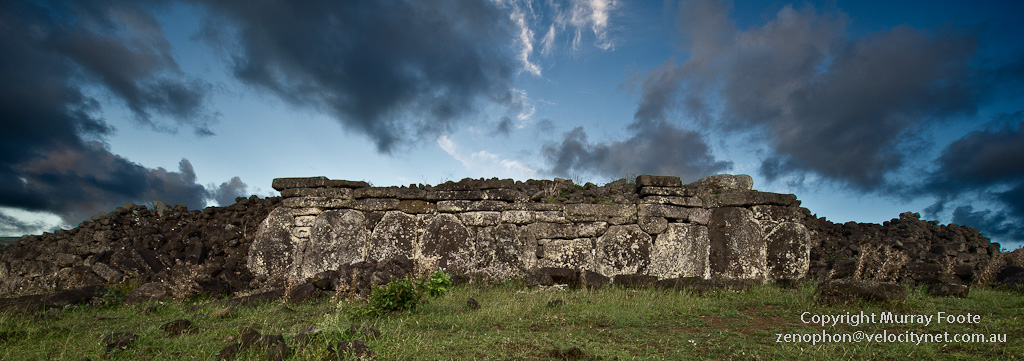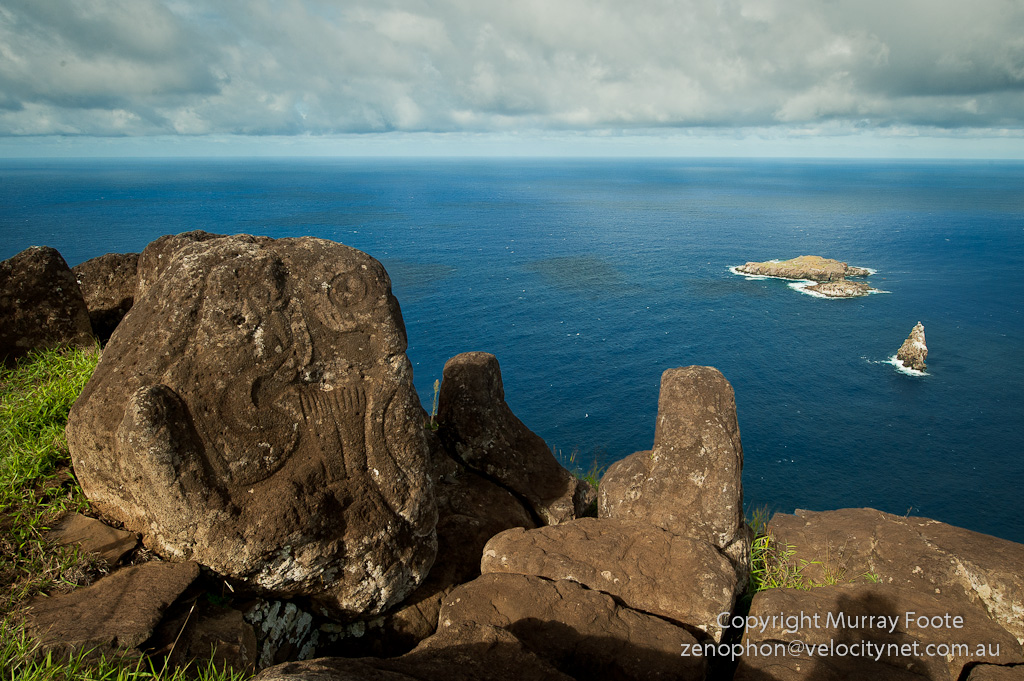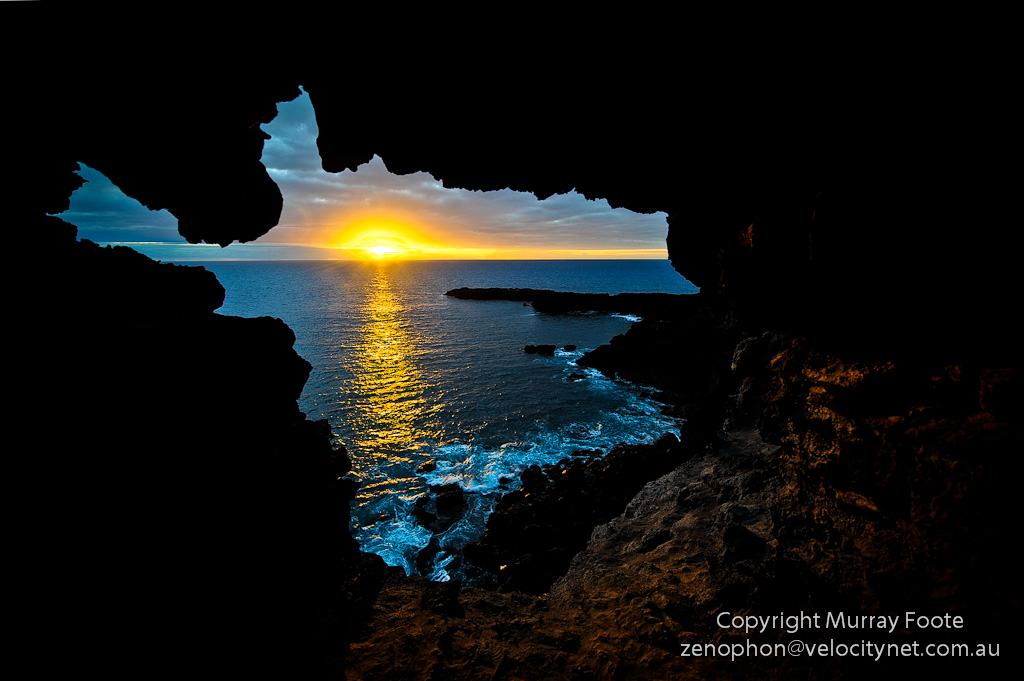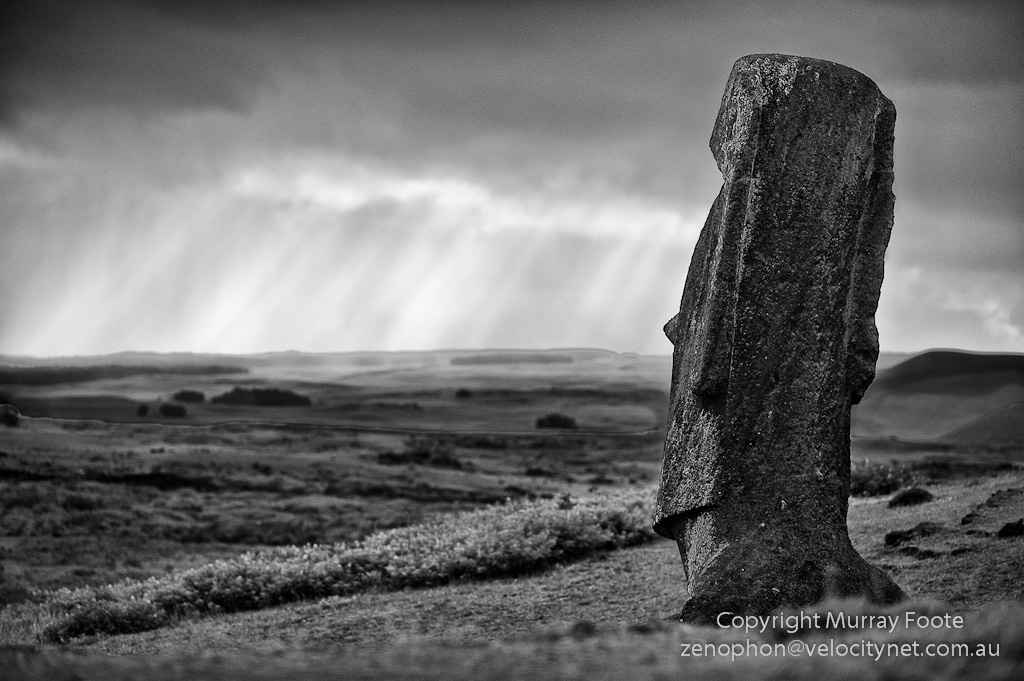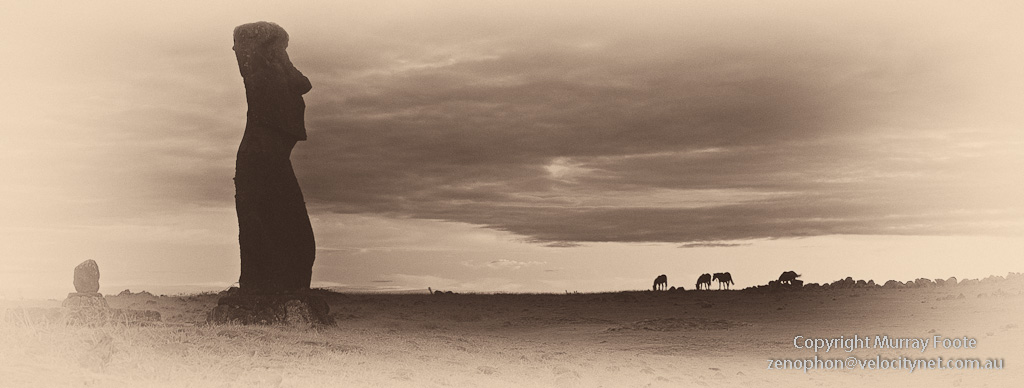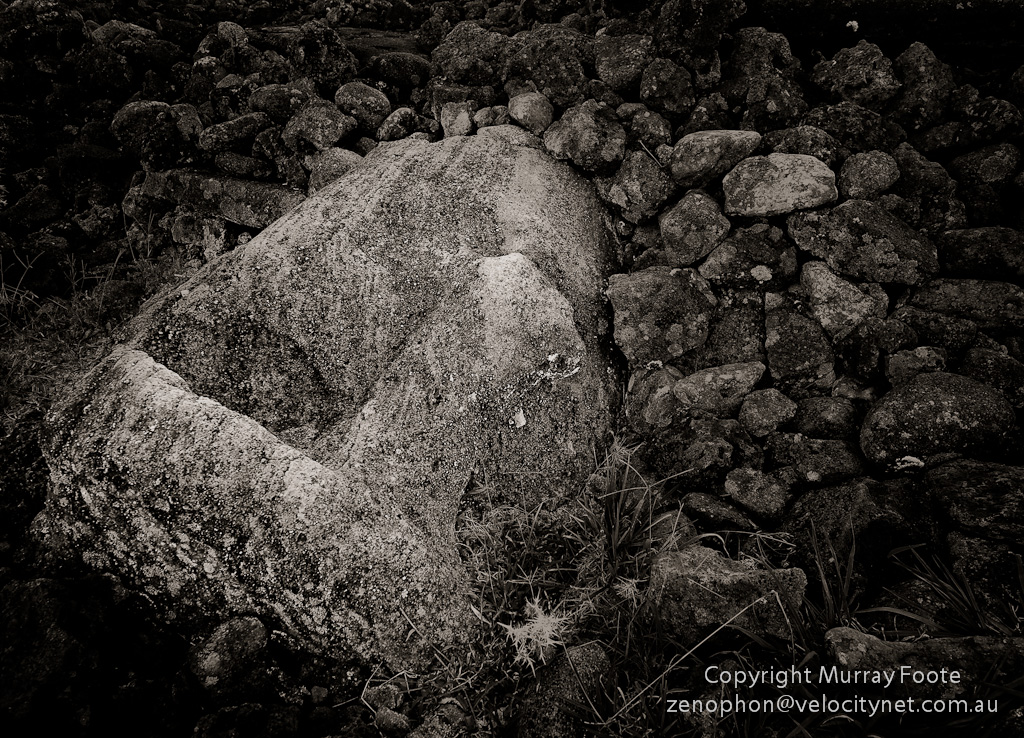Here is a
moai head lying beside the
ahu wall at
Ahu Te Peu, that we saw in the first image of this series.
Once, with its back to the sea, and when his eyes had been inserted by the
ivi atua, he looked out over a thriving village, part of a vibrant culture completely isolated from the rest of the world. Standing on the
ahu above the
avanga (funeral chambers ), he saw the
manavai (walled enclosures for gardens) and the huge
hare paenga (boat-shaped house, 40 metres long, the island’s largest).
He was a great ariki who had died some time ago. He saw all the members of the clan massed in the great square for the sacred ceremonies, singing and dancing, illuminated by the fires in front of the
ahu and calling to him to guarantee their prosperity. Then after the long years of famine and vicious killings, the people overturned the moai onto piles of stones so that the head broke off and the
mana was lost. Now he lay unseeing and forgotten, turned back to stone, facing up to the heavens and detached from his body.
(Note:
Mana means power, prestige and charisma, partly from elevated birth, partly due to great deeds. In the case of
moai on
ahu, their
mana resided chiefly in their eyes.)
For more on
manavai and
hare paenga and also a
boat ramp,
hare moa (chicken houses)/
tupa (tombs) and
umu (ovens), see the blog post on the
Tahai Complex. This also shows the only
moai on the island with restored eyes.
Is Easter Island a Parable for Our Times?
Easter Island is clearly a small island yet increasingly so is the Earth. Improvements in communication bring us all closer together, we can travel virtually anywhere within a few days, world-wide decentralised mass production makes all economies interrelated and increasingly there are many issues that affect the world as a whole. So back to the question – Does Easter Island present a parable relevant to the problems of the present?
- Deforestation
The World is not likely to fell all forests quite to the extent of Easter Island. For example, some countries such as Germany and Japan have had effective forest conservation policies for centuries. However, worldwide deforestation is a very serious problem.
Japan preserves its own timber but imports timber from other countries. Australia, for example, sells wood pulp to Japan for making paper. The prices are very low compared to the price of the paper yet in Australia’s fragile ecosystem, the forests regenerate extremely slowly. In most cases similar exporting countries are poor and in return for the wood, wealthy countries are exporting their deforestation problems to poor countries.
The largest remaining forests are in third world countries, especially the tropical rain forests of the Amazon and Zaire. About half of the tropical forest that existed in 1800 has already disappeared and at the current rate of destruction, there will be little left outside protected areas by 2050.
Timber may be increasingly in short supply in some countries. Deforestation can severely degrade cleared land as erosion removes soil, lowers the water table or increases salinity. The most serious issue, though, is the likely effect of deforestation on World climate.
- Water
As Captain Cook saw, availability of drinking water was a serious issue for the Rapanui. Most people take the supply of water for granted but it is slowly developing into a serious issue, for some countries at least. Many regions are drawing on underground reserves at an unsustainable rate. This water can be hundreds of thousands of years old and unrestricted drawing up of bore water can also cause problems in soil salinity.
There are also many areas where agriculture depends on spring runoff from glacial melt. Most glaciers are in rapid retreat and this kind of runoff may reduce substantially. For example, serious problems for agriculture in Northern India and Bangladesh are likely to develop due to sharply reduced spring water flows resulting from climate change.
- Species loss
The Rapanui managed to wipe out most of their wildlife. Essentially this was their birds, reduced from a great host to a few seabirds nesting on small offshore islands. We’re not at a comparable stage of species loss yet, although we’re heading in that direction. Already we are in the early stages of a global extinction event and it already has a name – the Holocene extinction. While this extinction event covers the whole 10,000 years of the Holocene, it mainly relates to the last couple of hundred years and the primary cause is human activity.
- Fishing
The Rapanui lost access to most of their fish stocks due to lack of wood for canoes which prevented ocean fishing. Our problem is rather different. We have no shortage of big metal canoes which bring back huge amounts of fish but we need to be careful we don’t strip the fishing stocks.
It is all too easy to view the oceans as an unlimited resource and awareness of this has improved since the 1970s and 1980s, particularly with the development of maritime reserves and aquaculture (farming of fish and other marine organisms). The main barrier to sustainability is illegal fishing, which can also devastate areas with illegal trawling methods.
International trade accounts for 38% of fish and fishery products, making it the most traded food in the world. Over 80% of that trade goes to developed countries, so if other countries continue to become more affluent, it is easy to see there could be greatly increased pressures of demand.
Easter Island’s deep sea fishing stocks and marine diversity were significantly reduced by illegal fishing in just the last few years. Without appropriate conservation measures, world fishing stocks could be essentially fished out by 2050.
- Overpopulation and Resources
Sometime after 1400, the Rapanui found themselves in an eroded, treeless land that had a reduced capacity to support them and with a population that had grown to an untenable size.
There can be no question that overpopulation is a serious issue for the world today. Population growth is most acute for Africa and to a much lesser extent, South America and India. We cannot isolate ourselves from this; increasingly, like the Easter Islanders, we are living in a small and shrinking island (the Earth). Just as with Easter Island, it’s not in anyone’s interest for one group to ride roughshod over the rest. In the words of John Kennedy:
If a free society cannot help the many who are poor, it cannot save the few who are rich.
One thing that can happen is that when a country sees it is overexploiting its resources, it takes measures to safeguard them but transfers the exploitation to other countries. This is ultimately self-defeating; when the resources of poorer countries are gone there is nowhere left to turn.
While developed countries often have stable population levels net of migration, they use disproportionately large amounts of resources compared to the world as a whole. Many of those resources come from less developed countries. Increasingly there are newly prospering nations that want a share (China, India, South East Asia). We are already familiar with the essentially fixed supply of petroleum that has already peaked. It seems likely that resources will not increase to meet demand this time around.
- War
Ecological crisis on Easter Island gave rise to vicious warfare. The same thing happened to the Southern Maya when their civilisation overran its ecological basis. Where nations face the exhaustion of resources upon which they depend, such warfare is obviously possible and war in our world can be truly horrific. We can only hope it doesn’t work out like that. At least some of the time, we may be able to contribute to public opinion and help prevent inappropriate, hasty or even illegal wars.
- Is there a Comparison with Easter Island?
Deforestation, water availability and species loss are serious problems for us though not often as severe as the outcomes that Easter Island experienced.
The Rapanui experienced a reduced supply of fish due to reduced capability to fish, though their fishing stocks, for deep water fish at least, were not greatly affected. We run some danger of exhausting world fishing supplies though effective measures may be in place, as long as we can control illegal fishing.
Easter Island experienced severe overpopulation (hand-in-hand with ecological degradation) and their capacity to take effective measures was probably hampered by excessive resource demands of the privileged elite. Many areas of our world suffer overpopulation, especially Africa, while the developed countries (and even elite groups within developed countries) tie up a high proportion of world resources.
So if that were it, we could say that there are strong parallels with Easter Island and also significant differences. The world is not as degraded as Easter Island became and we can still address the issues. In the worst case, we would need to settle for a degraded lifestyle, as did the Rapanui before the arrival of the Europeans.
However, we also have global warming and climate change to contend with and we need to be very sure we understand and deal effectively with those issues as well.
- Global warming and Climate Change
Sometime between 1400 and 1700, the Rapanui experienced an ecological crisis that resulted in starvation and warfare so that the population fell by 50% to 70%. After that, they may have reached a period of relative stability. They still had a viable agriculture although life was much less comfortable and the numbers they could support had fallen.
The issues for the current world that I have summarised above loosely correspond to the crisis that Easter Island went through before European contact. In the worst case, we will turn many regions arid while many species and a significant part of humanity will die. After some time, the chastened humans will regroup and hopefully develop a sustainable way of living under a reduced resource base.
Unfortunately, there is more to it than that. In the case of the Rapanui, the cataclysm of European contact – disease, exploitation and slavery –almost wiped them out after 1722. In our case, the somewhat equivalent danger has a quite different cause: global warming and the potential for climate tipping events.
Some people deny the possibility of global warming when they say “but it’s cold this year, there’s no warming at all”. This is to misunderstand what it is. Overall there is warming, the glaciers are melting, the oceans are getting warmer and giving rise to more hurricanes, but it also means greater climatic extremes and in the short-to-medium term, some regions will get warmer and drier while other may get cooler and wetter. It is true that there can be large natural variations in climate. It is also true that the great majority of scientists believe that global temperatures have been rising in the last 200 years and that this has a large man-made component. This view is virtually unanimous for climatologists, those scientists who specialise in climate and climate change.
The most unsettling risk is the possibility of the world ecosystem degrading to fundamentally change the conditions for life. It has happened before, in previous global extinction events. It could happen fairly quickly and only be reversible in the very long term, and then to a completely different world, a climate tipping event.
As it stands, if we keep on as we are without effective remedial action, the consequences will be severe. However, we are not yet at the point of no return. We can still turn things around. I think that no-one really knows how much time we have so it is better to act sooner rather than later. The complication is that there are significant lags involved. The effective action we take today may take several years to bite. If necessary, we must be prepared to take one step back to take two steps forward. If we wait until the situation is catastrophic, it might be too late to recover from.
